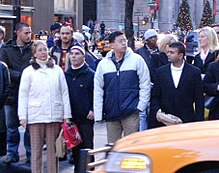
Back التعدد العرقي Arabic বহুজাতিকতা Bengali/Bangla Polietnicidad Spanish Multiethnisme French 다민족 Korean Polyetnisitet NB Polietnicidade Portuguese Polietniciteti Albanian Багатоетнічність Ukrainian 多民族性 Chinese

Polyethnicity, also known as pluri-ethnicity or multi-ethnicity, refers to specific cultural phenomena that are characterized by social proximity and mutual interaction of people from different ethnic backgrounds, within a country or other specific geographic region.[1]
Same terms may also relate to the ability and willingness of individuals to identify themselves with multiple ethnicities. It occurs when multiple ethnicities inhabit a given area, specifically through means of immigration, intermarriage, trade, conquest and post-war land-divisions.[2][3][4] This has had many political and social implications on countries and regions.[5][6]
Many, if not all, countries have some degree of polyethnicity, with countries like Nigeria and Canada having high levels and countries like Japan and Poland having very low levels (and more specifically, a sense of homogeneity).[7][8][9][10] The amount of polyethnicity prevalent in some Western countries has spurred some arguments against it, which include a belief that it leads to the weakening of each society's strengths, and also a belief that political-ethnic issues in countries with polyethnic populations are better handled with different laws for certain ethnicities.[11][12]
- ^ McNeil 1985, pages 85
- ^ Arabandi 2000, Online
- ^ Smith 1998, page 190
- ^ Smith 1998, page 200
- ^ Safran 2000, Introduction
- ^ Benhabib 1996, pages 154–155
- ^ U.S. Census Bureau
- ^ Thomson 2000, pages 213-215
- ^ Burgess 2007, Online
- ^ Safran 2000, pages 1-2
- ^ Robertson 1992, pages 1-10
- ^ Thomson 2000, pages 214–215